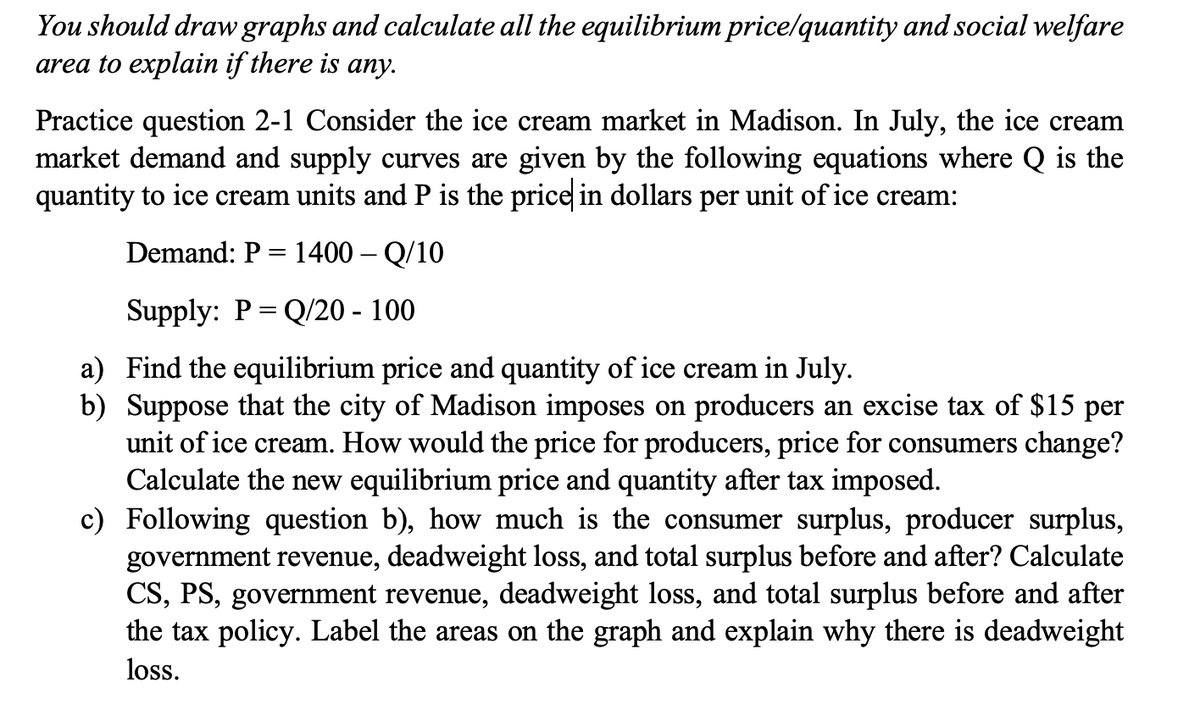You should draw graphs and calculate all the equilibrium price/quantity and social welfare area to explain if there is any. Practice question 2-1 Consider the ice cream market in Madison. In July, the ice cream market demand and supply curves are given by the following equations where Q is the quantity to ice cream units and P is the price in dollars per unit of ice cream: Demand: P = 1400 - Q/10 Supply: P = Q/20 - 100 a) Find the equilibrium price and quantity of ice cream in July. b) Suppose that the city of Madison imposes on producers an excise tax of $15 per unit of ice cream. How would the price for producers, price for consumers change? Calculate the new equilibrium price and quantity after tax imposed. c) Following question b), how much is the consumer surplus, producer surplus, government revenue, deadweight loss, and total surplus before and after? Calculate CS, PS, government revenue, deadweight loss, and total surplus before and after the tax policy. Label the areas on the graph and explain why there is deadweight loss.
You should draw graphs and calculate all the equilibrium price/quantity and social welfare area to explain if there is any. Practice question 2-1 Consider the ice cream market in Madison. In July, the ice cream market demand and supply curves are given by the following equations where Q is the quantity to ice cream units and P is the price in dollars per unit of ice cream: Demand: P = 1400 - Q/10 Supply: P = Q/20 - 100 a) Find the equilibrium price and quantity of ice cream in July. b) Suppose that the city of Madison imposes on producers an excise tax of $15 per unit of ice cream. How would the price for producers, price for consumers change? Calculate the new equilibrium price and quantity after tax imposed. c) Following question b), how much is the consumer surplus, producer surplus, government revenue, deadweight loss, and total surplus before and after? Calculate CS, PS, government revenue, deadweight loss, and total surplus before and after the tax policy. Label the areas on the graph and explain why there is deadweight loss.
Chapter4: Markets In Action
Section: Chapter Questions
Problem 1SQP
Related questions
Question

Transcribed Image Text:You should draw graphs and calculate all the equilibrium price/quantity and social welfare
area to explain if there is any.
Practice question 2-1 Consider the ice cream market in Madison. In July, the ice cream
market demand and supply curves are given by the following equations where Q is the
quantity to ice cream units and P is the price in dollars per unit of ice cream:
Demand: P = 1400 - Q/10
Supply: P = Q/20 - 100
a) Find the equilibrium price and quantity of ice cream in July.
b) Suppose that the city of Madison imposes on producers an excise tax of $15 per
unit of ice cream. How would the price for producers, price for consumers change?
Calculate the new equilibrium price and quantity after tax imposed.
c) Following question b), how much is the consumer surplus, producer surplus,
government revenue, deadweight loss, and total surplus before and after? Calculate
CS, PS, government revenue, deadweight loss, and total surplus before and after
the tax policy. Label the areas on the graph and explain why there is deadweight
loss.
Expert Solution
This question has been solved!
Explore an expertly crafted, step-by-step solution for a thorough understanding of key concepts.
Step by step
Solved in 5 steps with 2 images

Knowledge Booster
Learn more about
Need a deep-dive on the concept behind this application? Look no further. Learn more about this topic, economics and related others by exploring similar questions and additional content below.Recommended textbooks for you







Microeconomics: Principles & Policy
Economics
ISBN:
9781337794992
Author:
William J. Baumol, Alan S. Blinder, John L. Solow
Publisher:
Cengage Learning

Principles of Microeconomics
Economics
ISBN:
9781305156050
Author:
N. Gregory Mankiw
Publisher:
Cengage Learning
